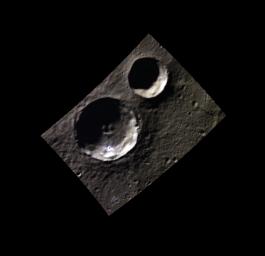Today's image features the crater Berlioz, a newly named crater within Mercury's northern plains. Berlioz is the larger crater in this image, with the central peak complex that ironically looks a bit like a smiling face. Hector Berlioz (1803-1869) was a French Romantic composer who was heavily inspired by Shakespeare and Goethe, in particular their works which involved tragedy. Among his most famous works is 'Symphonie fantastique', about a young musician's unrequited love.
This image was acquired as part of MDIS's 8-color base map. The 8-color base map is composed of WAC images taken through eight different narrow-band color filters and covers more than 99% of Mercury's surface with an average resolution of 1 kilometer/pixel. The highest-quality color images are obtained for Mercury's surface when both the spacecraft and the Sun are overhead, so these images typically are taken with viewing conditions of low incidence and emission angles.
Date acquired: September 24, 2011
Image Mission Elapsed Time (MET): 225356176, 225356184, 225356178
Image ID: 800533, 800538, 800534
Instrument: Wide Angle Camera (WAC) of the Mercury Dual Imaging System (MDIS)
WAC filters: 9, 7, 6 (996, 748, 433 nanometers) in red, green, and blue
Center Latitude: 79.85°
Center Longitude: 39.61° E
Resolution: 302 meters/pixel
Scale: Berlioz crater is 31.4 km (19.5 mi) in diameter.
Incidence Angle: 83.3°
Emission Angle: 0.1°
Phase Angle: 83.4°
Orientation: North is towards the right in this image.
The MESSENGER spacecraft is the first ever to orbit the planet Mercury, and the spacecraft's seven scientific instruments and radio science investigation are unraveling the history and evolution of the Solar System's innermost planet. MESSENGER acquired over 150,000 images and extensive other data sets. MESSENGER is capable of continuing orbital operations until early 2015.
For information regarding the use of images, see the MESSENGER image use policy.

 Planetary Data System
Planetary Data System












